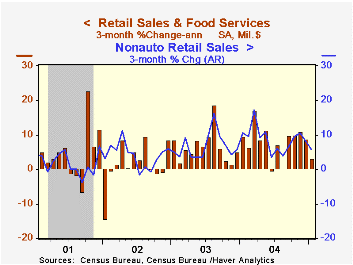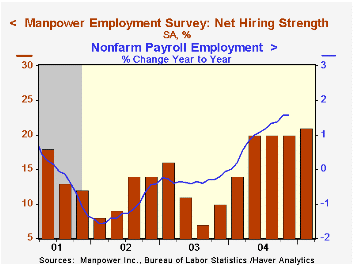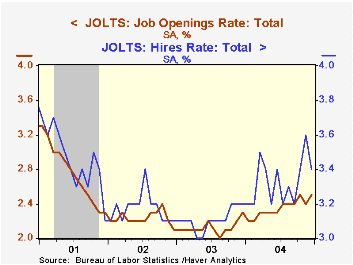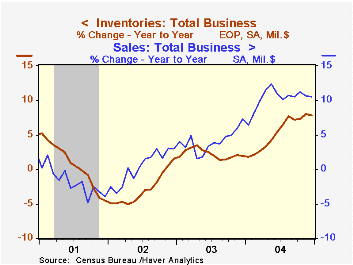 Global| Mar 15 2005
Global| Mar 15 2005U.S. Retail Sales Firm
by:Tom Moeller
|in:Economy in Brief
Summary
US retail sales rose 0.5% last month and about matched Consensus expectations. The gain was accompanied, however, by an upward revision to January sales which are now estimated to have risen 0.3% versus the initial report of a 0.3% [...]

US retail sales rose 0.5% last month and about matched Consensus expectations. The gain was accompanied, however, by an upward revision to January sales which are now estimated to have risen 0.3% versus the initial report of a 0.3% decline.
Sales excluding motor vehicles rose 0.4% in February following a revised 1.0% January increase which was nearly double the initial report. Consensus expectations had been for a 0.8% rise in February nonauto sales.
The tone of spending on discretionary items appears firmer than it did last month due to strong February increases and upward revisions to January results. Sales at furniture & home furnishings stores jumped 1.1% (5.9% y/y) after a 1.4% January spurt. Apparel store sales added 1.1% (5.0% y/y) to a 1.7% January leap and February sales at general merchandise stores rose 0.7% (6.6% y/y).
Sales of nonstore retailers (internet and catalogue) slipped marginally m/m (+12.5% y/y) but January now is estimated at up 1.0%.
Gasoline service station sales rose 0.9% (16.4% y/y) on the strength of a 4.3% increase in gasoline prices to an average $1.91 per gallon. In the latest week gasoline prices averaged a near record $2.06. Nonauto retail sales less gasoline rose 0.4% (7.5% y/y) in February after a 1.0% January increase
Building material store sales fell 1.3% (+13.1% y/y).
| Feb | Jan | Y/Y | 2004 | 2003 | 2002 | |
|---|---|---|---|---|---|---|
| Retail Sales & Food Services | 0.5% | 0.3% | 7.7% | 7.6% | 5.3% | 2.5% |
| Excluding Autos | 0.4% | 1.0% | 8.4% | 8.5% | 5.2% | 3.2% |
by Tom Moeller March 15, 2005

The Manpower Employment Outlook Survey indicated further growth in U.S. jobs. The 2Q05 index of hiring intentions held at 21 and was nearly double the index's level two years ago. The index indicates that a net 21% of 16,000 employers expect to increase hiring activity.
Since 1980 there has been a 74% correlation between the Manpower index and the y/y change in non-farm payrolls.
Not seasonally adjusted, 30% of employers planned to raise employment in 2Q04, the highest since late 2000, while only 7% planned to decrease employment.
Improvement in hiring intentions versus last year was widespread across industries but notable in finance/insurance/real estate, education and public administration. Moderate improvement continued in manufacturing industries but the gains contrast with net job loss three years ago.
The latest press release from Manpower Inc. covering global employment prospects can be viewed here.
| Manpower Employment Survey | 2Q '05 | 1Q '05 | 2Q '04 | 2004 | 2003 | 2002 |
|---|---|---|---|---|---|---|
| All Industries - Net Higher (SA) | 21 | 21 | 20 | 19 | 11 | 11 |
by Tom Moeller March 15, 2005

The Job Openings & Labor Turnover Survey (JOLTS) from the Bureau of Labor Statistics indicated the job openings rate eased in January to 2.4% versus 2.6% in December. The job openings rate is the number of job openings on the last business day of the month as a percent of total employment plus job openings.
The hires rate held in January at December's upwardly revised 3.5%. The hires rate is the number of hires during the month divided by employment.
The total number of job openings fell 5.8% (+15.4% y/y) after a 7.0% gain in December.
Job separations fell 1.7% m/m (+9.2% y/y). The separation rate held steady at 3.3%. Total separations include quits, layoffs, discharges, and other separations as well as retirements. The total separations, or turnover, rate is the total number of separations during the month divided by employment.
The survey dates only to December 2000 but has since followed the movement in nonfarm payrolls.
From the U.S. Department of Labor, a description of the Jolts survey and the latest release is available here.
| JOLTS (Job Openings & Labor Turnover Survey) | Jan | Dec | Jan '04 | 2004 | 2003 | 2002 |
|---|---|---|---|---|---|---|
| Job Openings Rate: Total | 2.4% | 2.6% | 2.1% | 2.4% | 2.1% | 2.2% |
| Hires Rate: Total | 3.5% | 3.5% | 3.3% | 3.4% | 3.2% | 3.2% |
by Tom Moeller March 15, 2005

Total business inventories jumped 0.9% in January following an unrevised 0.2% December rise. The pace of inventory accumulation has accelerated markedly since 2002 but has not kept pace with the improvement in sales growth. Consequently the ratio of inventories-to-sales fell through last year and in January remained at the record low.
Inventory accumulation was strongest in January at the factory level where a 1.3% gain was the largest monthly increase since 1988.
Wholesale inventories jumped 1.1%. During the last ten years there has been a 64% correlation between the y/y change in wholesale inventories and the change in imports of merchandise.
Retail inventories rose 0.4% in January following a 0.3% December increase. Accumulation of non-auto retail inventories, however, again was quite strong up 0.8% led by a 19.8% y/y gain in building materials and a 7.8% y/y rise in furniture & electronics.
Overall business sales jumped 0.8% (+11.1% y/y).
| Business Inventories | Jan | Dec | Y/Y | 2004 | 2003 | 2002 |
|---|---|---|---|---|---|---|
| Total | 0.9% | 0.2% | 8.6% | 7.9% | 1.9% | 1.5% |
| Retail | 0.4% | 0.3% | 6.4% | 6.0% | 5.0% | 6.0% |
| Retail excl. Autos | 0.8% | 1.1% | 7.5% | 6.5% | 2.9% | 2.6% |
| Wholesale | 1.1% | 0.4% | 12.3% | 11.2% | 2.2% | 0.4% |
| Manufacturing | 1.3% | 0.1% | 8.5% | 7.5% | -1.3% | -1.8% |
Tom Moeller
AuthorMore in Author Profile »Prior to joining Haver Analytics in 2000, Mr. Moeller worked as the Economist at Chancellor Capital Management from 1985 to 1999. There, he developed comprehensive economic forecasts and interpreted economic data for equity and fixed income portfolio managers. Also at Chancellor, Mr. Moeller worked as an equity analyst and was responsible for researching and rating companies in the economically sensitive automobile and housing industries for investment in Chancellor’s equity portfolio. Prior to joining Chancellor, Mr. Moeller was an Economist at Citibank from 1979 to 1984. He also analyzed pricing behavior in the metals industry for the Council on Wage and Price Stability in Washington, D.C. In 1999, Mr. Moeller received the award for most accurate forecast from the Forecasters' Club of New York. From 1990 to 1992 he was President of the New York Association for Business Economists. Mr. Moeller earned an M.B.A. in Finance from Fordham University, where he graduated in 1987. He holds a Bachelor of Arts in Economics from George Washington University.






